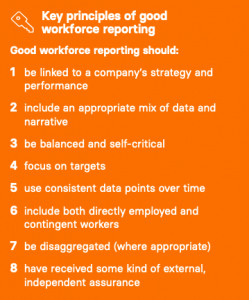Transparency in workforce reporting will help catalyse change. A blog by HPC researcher Harry Window, written for Board Agenda.
The importance of an authentic engagement with the workforce should be considered a priority for any employer. There is firstly a material argument for this, as a developed and esteemed workforce is more productive. Moreover, there is also an ethical argument, as an employer has a duty to consider and improve the well-being of its workforce.
Previous research by the High Pay Centre analysed the extent to which FTSE 100 companies detail their employment models and working practices in their annual reports. It is a welcome development that more space in reports is being dedicated to a focus on the workforce. This demonstrates an understanding of the importance of good employment practices, and that mismanagement of the workforce represents a principal risk.
However, increasing the length of reports does not necessarily mean improving quality. Workforce reporting is overwhelmingly dominated by narrative reporting, rather than disclosing quantitative metrics. For example, whilst 97% of companies acknowledged the importance of skills and training to their organisation, far fewer provided any concrete evidence of what they are doing about it – only 35% disclosed hours of training per employee, and 16% calculated their total investment in training. Whilst it might not be expected that all companies would disclose on this metric, it shows the large discrepancy between companies who discuss it, and those who provide quantitative, measurable data.
Following the observation that narrative reporting greatly outweighs concrete data in workforce reporting and dialogue with companies, the High Pay Centre has now authored new guidance, published by Railpen and supported by the CIPD and PLSA highlighting useful metrics that provide investors with insights into the composition, stability, skills and engagement levels of the workforce for their investees. The guidance also cites examples of how these metrics are already being used in corporate reporting. The document explores five key reporting themes:
- Workforce cost and composition
- Employee relations and wellbeing
- Reward
- Worker voice
- Skills, capabilities and recruitment
Changing the workforce reporting landscape
The document can act as a tool for engagement and discussion and to contribute to the evolving debate on workforce disclosure. By outlining examples of good practice, the report helps to move the debate about the importance of the workforce and the ‘S’ of ESG on from discussion of these issues to practical ways that they can be incorporated into business practice, in terms of reporting.
Whilst not all metrics in the guidance will be relevant to all companies, and it would not be reasonable or necessary for every company to report on every single one, they do all represent useful proxies for measuring how well a company is managing and developing its workforce. The fact that all the metrics in the document are already being used by at least some companies, shows that reporting on them is feasible and useful.
The aim of this guidance is to help companies to improve their reporting and to support investors’ engagements with portfolio companies. Railpen has noted portfolio companies that have engaged with investors to discuss better options for workforce reporting.
The document will support better stewardship of investee companies by investors, and better board-investor dialogue around workforce issues. Investors can use the guidance as a framework for asking boards to substantiate narrative explanations of their employment models and working practices. Boards can use the metrics to help develop reporting (either formally in annual reports or through private shareholder meetings) on these topics that are useful to investors.
Concrete data can be much harder to ‘spin’ than narrative reporting. Understandably companies want to accentuate a positive case for their business and are sensitive to an external environment where the media or short term investors will seize upon anything negative to generate a story or make some money on the markets.
But businesses that are transparent about challenges they face are more likely to overcome them. Indeed, they may well find this leads to better support in improving their business from investors who are often able to share advice and experience from across their portfolio of companies. Any reasonable investor is surely likely to see a reflective and honest business as a much better long term prospect than one that denies or obscures its problems.
In this respect, the guidance on workforce reporting can not only support better documentation of companies employment models and working practices, but also help to establish a better model for board-investor dialogue more generally, based on transparency, trust and understanding. Improved trust and dialogue will accelerate transparency, as businesses do not shy away from that which might be perceived as ‘bad news’ but instead acknowledge it, providing context and offering measurable solutions.
Workforce reporting should therefore be considered a valuable tool for all stakeholders, leading to better outcomes and decisions. Stakeholders can better understand issues such as job security, staff retention, diversity and inclusion and employee engagement. This will also ensure risks associated with the workforce and management practices are carefully considered. Therefore, helping business leaders and investors in improving reporting practices is hugely beneficial.

Bringing positive change to the workplace
Through discussion is to emphasise what is possible when companies report on their workforce. With an overriding objective of transparency, it is possible to catalyse change within organisations. As the workplace is a significant aspect of employee lives, it is important to engage with the workforce in an intentional way.
Businesses which have an honest and considered approach to social sustainability will create value. Fostering a reflective and considerate approach to the workforce and how it is reported on will ultimately benefit all stakeholders. Understanding and disclosing this information will lead to more informed decisions, minimising risk, increasing trust and ultimately bringing positive change throughout the organisation.